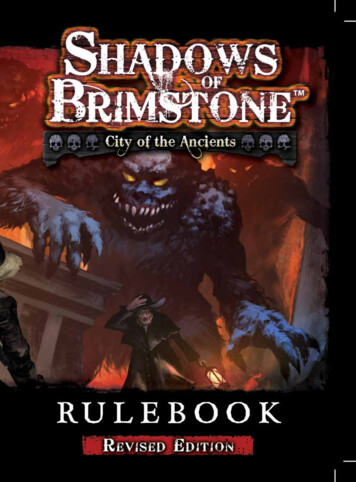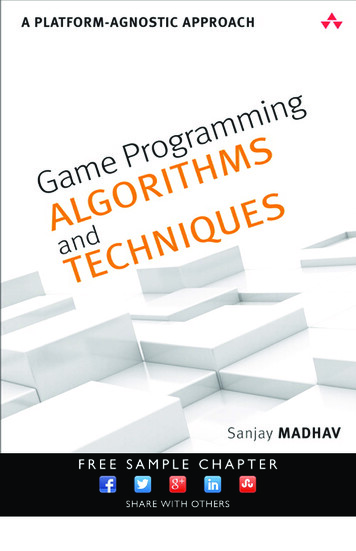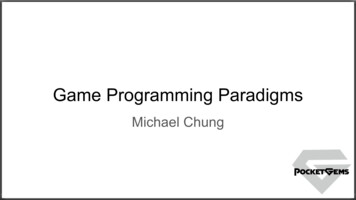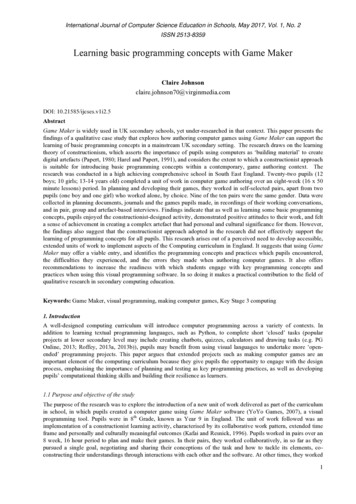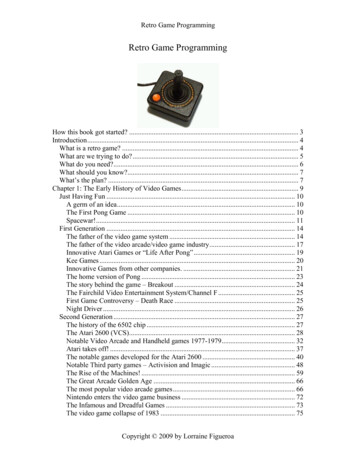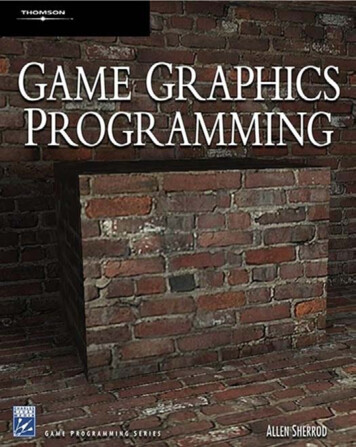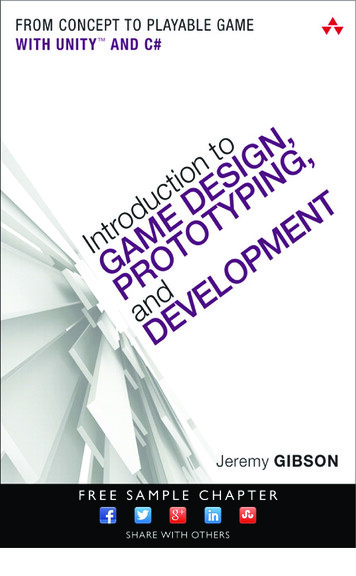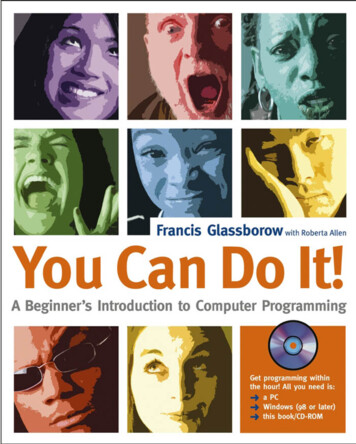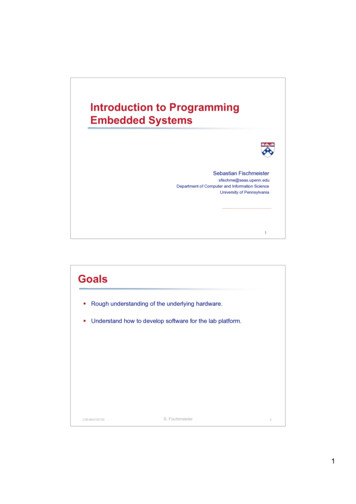
Transcription
Introduction to GameProgrammingSteven Osmansosman@cs.cmu.edu
Introduction toGame ProgrammingIntroductory stuffLook at a game console: PS2Some Techniques (Cheats?)
What is a Game?Half-Life 2, Valve
Designing a GameComputer ScienceArtMusicBusinessMarketing
Designing a GameMusicArtComputer olitics Just to name a few
Designing a GameFind out more from an industry veteran @Professor Jesse Schell’s class:Game Design(Entertainment Technology Center)
The Game EngineGraphics & AnimationPhysicsController InteractionAI PrimitivesSoundNetworkingScripting system
The Game LogicGame rulesNon-Player Characters (NPC) AIInterface, etc.Often (but not necessarily) implemented inscripting language
Magic lyGameRules
Game Programming is hard Players want complex graphics (why?)Game must run fast (30fps )AI isn’t exactly trivialWe want networking but no latencyPhysics is already hard. Now do it in realtime And do it all in time for Christmas
To most, this is the PS2
To technophiles, this is a PS2
To us, this is the PS2Source: http://playstation2-linux.com/projects/p2lsd
Emotion Engine Core “EE Core”Source: http://playstation2-linux.com/projects/p2lsd
Emotion Engine Core “EE Core”Runs at about 300 megahertzMIPS I & II, subset of MIPS III & IVMath coprocessorSIMD Instructions16k instruction cache8k data cache16k scratch pad
SISD InstructionsSingle Instruction, Single DataInstructionsDataResultsModified from: .ars/5
MIMDMultiple Instruction, Multiple DataSource: .ars/5
SIMDSingle Instruction, Multiple DataSource: .ars/5
Which is Better?Sure, 4 independent instruction streams(MIMD) would be nice, but it would requiremore memoryBut media applications do not requireinstruction-level parallelism, so SIMD isfine
Sneak PeekThe safe money says next generation fromSony will be highly parallel ( MIMD)There’s a good chance that this may includeparallel SIMD instructionsNow go ask your Architecture professorwhat that’s even called! (I like MIM2D)
PS2 SIMD SupportPS2 has lots of SIMD support:Parallel instructions on core CPU 2x64-bits, 4x32-bits, 8x16-bits or 16x8-bitsÆ Homework 4 exampleVector Unit 0 through micro & macro modeVector Unit 1 Both VU’s do 4x32-bit floating point
SISD Example:Vector/Matrix Multiplication a e i mxyzw a*se*si*sm*s bfcgjnkob*tf*tj*tn*t d s x h t y * l u z p v w c*ug*uk*uo*u d*vh*vl*vp*v16 multiplications, 12 additions.Additions can be eliminated with MADD.
SIMD Example:Vector/Matrix Multiplication a e i mbfcgjnkod s x h t y * l u z p v w First, load columns into registers:VF03 {c, g, k, o}VF01 {a, e, i, m}VF04 {d, h, l, p}VF02 {b, f, j, n}VF05 {s, t, u, v}
SIMD Example:Vector/Matrix MultiplicationVF01 {a, e, i, m}VF03 {c, g, k, o}VF02 {b, f, j, n}VF04 {d, h, l, p}VF05 {s, t, u, v}MUL ACC, VF01, VF05[x]MADD ACC, VF02, VF05[y]MADD ACC, VF03, VF05[z]MADD VF06, VF04, VF05[w]// acc {a*s, e*s, i*s, m*s}// acc {b*t, f*t, j*t, n*t}// acc {c*u, g*u, k*u, o*u}// VF06 acc {d*v, h*v, l*v, p*v}Only 4 instructions! (compared to 16 or 28 instructions)
SIMD Example ContinuedMatrix/Matrix multiplication is 4 dot productsCompare:16 ( 4 x 4) instructionsto64 ( 4 x 16) assuming MADDor112 ( 4 x 28) instructions, without MADD!
Vector Units (VU0 & VU1)Source: http://playstation2-linux.com/projects/p2lsd
Vector Units (VU0 & VU1)VU0 – 4k data, 4k code Can be used in “Micro” or “Macro” modeVU1 – 16k data, 16k code Micro mode only Connected directly to the GS Can do clipping & a few more instructions
Vector Unit Vertex Shader?Absolutely not.The vector units do much, much more thana vertex shader!At the most trivial level, a vertex shader (notsure about the absolute latest) cannotcreate geometry.
What are they for?One approachVU0: Animation, Physics, AI, Skinning, etc VU1: Transformation, clipping & lightingAnother approachVU0: Transformation, lightingVU1: Transformation, lighting* I don’t think anyone ever uses it this way
Graphics Synthesizer (GS)Source: http://playstation2-linux.com/projects/p2lsd
Graphics SynthesizerThe “graphics chip” of the PS2Not a very smart chip! but a very fast one.Supports: Alpha blending Z Testing Bi- and tri-linear filtering
Graphics Synthesizer (GS)Per-second statistics:2.4 gigapixel fill rate150 million points50 million sprites75 million untextured triangles37.5 million textured triangles
I/O Processor (IOP)Source: http://playstation2-linux.com/projects/p2lsd
I/O Processor (IOP)Built from a PlayStation!Gives backward compatibilityIOP used to access the Sound ProcessingUnit (SPU2), controllers, CD & Hard Drive,USB and FireWire portIOP has 2MB memorySPU has 2MB memory
Image Processing Unit (IPU)Source: http://playstation2-linux.com/projects/p2lsd
Image Processing Unit (IPU)MPEG 2 decoding supportAt a high level, hand over encoded data,retrieve results when they’re ready
The Job of a PS2 ProgrammerKeep the system busy!Have all processors running Double buffer everything Reduce waiting on othersÆStream textures for next modelwhile processing current model Reduce data dependency stalls Pair instructions where possible
The Job of a PS2 ProgrammerAvoid stalling on memory access Use the scratch padAvoid cache misses as much as possible Use the scratch pad Code & Data locality Avoid C overdose Prefetch data into cache
Source: http://www.research.scea.com/
Source: http://www.research.scea.com/
Frame Rate DropSource: http://www.research.scea.com/
Let’s draw a triangleUltimate goal is to prepare a “GIF Packet”:GIF tagÆ Description of data to followRegister data (already transformed & lit)Æ XYZ CoordinatesÆ RGB ColorsÆ UV or ST Texture coordinates
Sample GIF Packet (Parsed)
Let’s draw a triangleStep 1 (EE): Do animation to update object,camera & light matricesStep 2 (EE): Cull objects that cannot beseenStep 3 (EE): Send camera, lights anduntransformed objects to VU, texture toGSSo far, just like OpenGL, right?
Let’s draw a triangleStep 4 (VU1): Transform vertices, do “trivialclipping”Step 5 (VU1): Non-trivial clipping – chop uptriangles. More triangles or triangle fan.Step 6 (VU1): Compute lightingStep 7 (VU1): Assemble GIF packetStep 8 (VU1): Kick data to GS
Case Study 1: Shadows
Stencil BufferStencil Buffer is sort of like the Z-Buffer:Additional bit plane(s) that can determinewhether a pixel is drawn or not.
OpenGL Stencil Buffer SupportglutInitDisplayString("stencil 1 rgb depth double");glutCreateWindow("stencil buffer example"); glClearStencil(0); // clear to zeroglClear(GL COLOR BUFFER BIT GL DEPTH BUFFER BIT GL STENCIL BUFFER BIT); glEnable(GL STENCIL TEST);glDisable(GL STENCIL TEST);Tests: never, always, , ! , , , , some valueSource: http://developer.nvidia.com
OpenGL Stencil Buffer SupportTo use the stencil buffer:glStencilFunc(GL EQUAL, // comparison function0x1, // reference value0xff); // comparison maskTo update the stencil buffer:glStencilOp(GL KEEP, // stencil failGL DECR, // stencil pass, depth failGL INCR); // stencil pass, depth passglStencilMask(0xff); // Which bits to updateSource: http://developer.nvidia.com
Case Study 2:Normal MappingWhat if we could read in normals from atexture?Source: http://playstation2-linux.com/download/p2lsd/ps2 normalmapping.pdf
Normal MappingSource: http://playstation2-linux.com/download/p2lsd/ps2 normalmapping.pdf
Normal MappingThese normals don’t need to be simpleinterpolations of the vertices – we can addthe appearance of detailWith a “pixel shader,” it’s fairly easy – ateach pixel, read in the normal from themapCan it be done without one?
Normal MappingHigh-level Overview:Instead of a texture being color values, let itbe normal values.Instead of vertex colors being colors ofedges, let them be light direction from thatedge.
Normal MappingNow when we render the scene we get:v.r*t.r, v.g*t.g, v.b*t.b(v vertex color, t texture color)But since v l, and t n We just need to add the r, g, b for n dot l !Just multiply the resulting colors by the lightintensity, I
Bump MappingTake a height-fieldCompute its gradientThis gives you “deltas” to add to your currentnormals
Bump MappingTop images from: http://www.3dxperience.com/html/resources.html
The future?
Case Study 3:Simple Motion DetectionImage A {ra1, ga1, ba1, ra2, ga2, ba2, }Image B {rb1, gb1, bb1, rb2, gb2, bb2, }PixelChangeBitmask {C1, C2, }Where Ci changed(rai, rbi) changed(gai, gbi) changed(bai, bbi)
Simple Motion DetectionTrivial Changed(a, b) {bigger max(a,b);smaller min(a,b);return a-b delta;// orreturn a-b delta && a * fraction b;}
Game Programming Introductory stuff Look at a game console: PS2 Some Techniques (Cheats?) What is a Game? Half-Life 2, Valve. Designing a Game Computer Science Art Music Business Marketing. Designing a Game Music Art Computer Science Business Marketing History Geography Psychology Sociology Physics Literature Education Writing Civics/Politics Just to name a few. Designing a File Size: 1MBPage Count: 59
